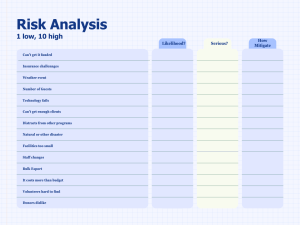
How to Overcome Risk Aversion in Nonprofit Boards
Perhaps you remember the Oscar-winning children’s film Frozen. Frozen tells the story of two sisters, Anna and Elsa. Elsa is an unusual child: she can freeze things. When Elsa creates snow slides, both sisters have a blast. When Elsa accidentally freezes Anna, trouble ensues. Like Elsa, who freezes her sister, nonprofit boards can unintentionally freeze the wrong thing. While Elsa’s powers are magical, the way boards hold back on opportunities is authentic—and can have lasting consequences.
Let me explain.
Nonprofit leaders shy away from risks.
Perhaps your board is satisfied with the status quo. Things are going well after some bumps in the past. Even though everything’s not perfect, why upset the apple cart? If it’s not broken, why fix it?
Who can blame them?
Avoiding risks protects current assets. Avoiding change avoids consequences. You avoid negative feedback if you fail. For example, many nonprofits still remember the hardships and fears of COVID and the Great Recession.
However, when board members automatically avoid risks, they freeze—and kill—opportunities.
Of course, no one sets out to deliberately freeze valuable opportunities. It’s just that saying no is easier and less work than conducting a risk assessment—calibrating the likelihood of an event happening and the seriousness of the consequence if it occurs.
Board Risk Aversion Example
CEO Laura articulated her frustrations with her organization’s income diversification efforts several years ago. I recommended several options, including my mentor program, to develop a revenue strategy. Laura and her board loved the objectives and the proposed results, but the board froze and voted no. The following month, they decided to invest the funds they had set aside for capacity growth on new lobby furniture. (You can’t make this stuff up!) By now, the furniture is worn, Laura’s moved on, and the nonprofit’s revenue has been slowly dropping for a decade.
Growing—even maintaining organizations—requires taking risks.
Atrophy means your organization shrinks.
Taking calculated risks improves decision-making in the long term—determining what does and doesn’t work. Even if a worst-case scenario happens, the decision leads nonprofits to more wisdom, solutions, and possibilities. Acting on smart risks teaches us about our challenges and opens new options.
Most important, low-probability/low-consequence risks often succeed. The actions create results. They solve problems. Most groups I work with see their investments returned tenfold or more. It’s thrilling to be doing something! It bubbles hope in the ranks. Working together, we take calculated risks. We measure the results. As necessary, we adjust the course to manage risks.
How to Calculate Nonprofit Risk
Risk analysis involves assessing potential risks by evaluating their likelihood and severity. This process helps nonprofits make informed decisions, turning potential threats into manageable challenges or opportunities.
To succeed, take risks. Help your board take them. How can you take intelligent risks? Calculate them in advance. See the chart below. To use it, list all the risks that occur to you (or the board). Then, rank the risks in terms of their likelihood and seriousness. For serious risks, even if unlikely, identify mitigation options.
Why This Risk Analysis Tool Is SO Valuable
Naming and analyzing your risks invites collective wisdom. Before taking action, ensure everyone identifies potential risks. By collectively assessing the likelihood and severity of each risk, you can pinpoint those that require mitigation. Staff can address minor and unlikely challenges if they happen; serious issues benefit from planning.
Ingenious nonprofits choose carefully. Whenever possible, they pick low-seriousness and low-consequence options. Once they act, these advanced calculations prepare them to mitigate risks.
Got Risk? A Nonprofit Risk Mitigation Example
Here’s an example from the Museum of Science and Industry (MOSI) in Tampa, Florida, the fifth-largest science center in the United States. Several years ago, it predicted a $40,000 budget shortfall. To solve the budget challenge, MOSI gathered a team of staff and volunteers. Participants created ten money-generating activities to reduce the deficit. Six failed. Four succeeded and closed the budget shortfall.
The most successful was built around Yu-Gi-Oh! Trading cards, which at the time were a rage with teens.
Taking a risk, MOSI marketed the first Yu-Gi-Oh! The tournament is on a listserv, and there is a press release (free except for staff time). For prizes, it bought Yu-Gi-Oh! Cards that could be sold in the gift store—mitigating the risk of the cards’ cost.
The first tournament took place on a Sunday morning when MOSI was slow. That day, MOSI admitted 400 guests at ten dollars each—an extra $4,000 for a half day’s work. Over the following months, MOSI hosted twice-monthly Yu-Gi-Oh! Tournaments and helped eliminate the deficit.
Here are the ingenious, risk-mitigating, repeatable tactics MOSI used:
- Find multiple solutions. MOSI generated ten ideas.
- Identify the risks associated with them and reduce them.
- Pilot solutions. MOSI began with a one-time tournament and used trading cards for prizes and free media.
- Measure results. Four solutions generated income.
- Anticipate failure. Six ideas failed.
- Capitalize on success. As long as the fad engaged youth, MOSI held Yu-Gi-Oh! Tournaments.
MOSI took ten calculated low-risk actions.
Got Risk? How to Convince Your Nonprofit Board to Invest in Strategic Planning
Lots of nonprofit boards struggle with investing in strategic planning. The risks they list include areas such as:
- Financial concerns: “We have too much to do with our budget.”
- Lack of immediate tangible results.
- Misperceptions about strategic planning and bad experiences.
- Fear of addressing the elephant in the room.
- Upcoming board changes.
Using the risk analysis chart above can help overcome these concerns if this is your board. By discussing the issues and evaluating how likely and severe they might be, boards can better understand the true impact of these risks and identify ways to mitigate them in advance.
However, don’t forget to also analyze the risk of not having a strategy– knowing how you will win and forgoing the strategic planning process. The process renews energy, aligns people, and lifts fog by engaging nonprofit stakeholders in making their future.
Moreover, strategic planning isn’t just about setting goals—it’s a way to navigate risks. If your board is concerned about risks, by engaging in strategic planning, they can proactively address potential challenges, ensuring that risks are managed before they become obstacles.
Your Nonprofit’s Risk Sweet Spot
We admire risk-takers for good reasons. Risks are necessary. Risks require courage.
Not all risks are the same. Ingenious boards and CEOs calculate their risks and act to grow their organizations. The ‘Risk Sweet Spot’ is where boards balance being overly cautious and taking unnecessary gambles. It’s where calculated risks lead to growth and innovation.
Don’t let fear freeze your organization’s potential. By understanding and embracing calculated risks, your board can unlock new opportunities and drive your mission forward.
Questions about evaluating risks? Don’t hesitate to reach out to discuss how we can partner to create a strategic plan that explores your risks and renews your nonprofit today.
Karen Eber Davis is a nonprofit strategic planning consultant who works with visionary leaders committed to taking their organizations to new heights. She offers customized strategies, assessments, and coaching designed to help leaders lead their organizations to achieve their potential. She is the author of 7 Nonprofit Income Streams and Let's Raise Nonprofit Millions Together.
Categories
If you appreciate these Added Value posts, please consider subscribing.
Latest Posts
- How New Nonprofit CEOs Secure Board Buy-In for Strategic Planning
- How Nonprofit Leader Navigate Crisis with Clarity & Confidence
- One Way AI Can Help You Find a Path Where None Exists
- In Crisis? Resist Cutting Your Ability to Make Income
- Nonprofit Strategic Planning Assessment: 10 Questions About Your Strategy

